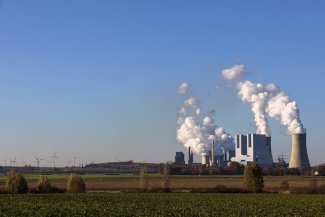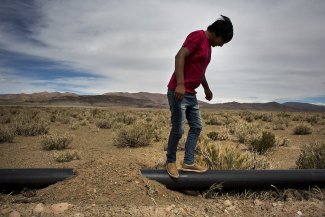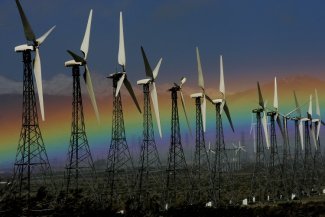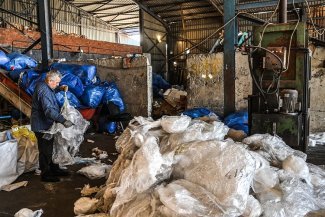E tū union members meet Prime Minister Jacinda Ardern at the Taranaki Just Transition Summit in May 2019. The landmark Taranaki 2050 Roadmap was created in 2018 to help the Taranaki region transition away from high-carbon sectors to a prosperous green future by 2050.
The name Taranaki doesn’t currently inspire instant recognition for most people outside of New Zealand. A green and fertile region perched on the edge of the North Island’s west coast, it was put on the tourism map in 2017 when the Lonely Planet travel guide ranked Taranaki second in its global Top 10 Regions list. Aside from that, this region of 120,000 people has a strong Māori presence and is known as the ‘Texas of New Zealand’ thanks to its large oil and gas reserves. It is also a hub for dairy production and agriculture in the country.
But Taranaki has formulated an ambitious blueprint for just transition which could put it on the world map. In 2018, the New Zealand government banned any future offshore oil and gas exploration in the country, spurring the creation of the Taranaki 2050 Roadmap. A landmark joint project involving government, workers, employers, Māori, local communities, civil society and other stakeholders, the roadmap is spearheaded by the region’s economic development agency Venture Taranaki with the aim of plotting what Taranaki’s low-carbon future might look like once it moves away from its high-carbon sectors, particularly oil and gas, and dairy farming.
There are still an estimated 20 oil and gas fields operating in Taranaki, directly employing an estimated 4,300 people, with thousands more jobs linked to industry supply chains. The 2018 announcement initially sparked concerns about job losses with one report estimating that unemployment in the region would increase by 4.7 per cent, but that’s where the just transition strategy comes in: the move away from polluting industries won’t happen overnight but strong social dialogue between all elements of the community is crucial to ensure that no worker is left behind by decarbonisation.
“Eventually, all of us will have to confront the fact that we have to act on climate change. In Taranaki, they’re doing that sooner than most,” says Sam Huggard, a strategic researcher at E tū (meaning ‘stand tall’), New Zealand’s biggest private sector union representing six industries.
E tū participated in several brainstorming sessions and roadshows organised by Venture Taranaki between February and April 2019 to hear the ideas of as many people living and working in Taranaki as possible on what the region’s economic future could look like over the next three decades. “Workers from these fossil fuel industries who have helped build the prosperity that New Zealand has enjoyed deserve the certainty of a pathway into decent, well-paying jobs in new industries,” says Huggard.
There were conversations about how to diversify and greenify the economy in Taranaki for people who would otherwise have their job security and livelihoods threatened. Once everyone’s initial thoughts were collected, the best ideas were streamlined into more concrete ‘transition pathway action plans’, which were progressively published from late 2019 to August 2020. The final Roadmap was published in July 2019. E tū sent eight member-leaders to the launch of the Taranaki 2050 Roadmap Summit in May 2019 who “have been trained in understanding the concept of just transition and will form a bridge between the roadmap process and the union members in their respective industries,” Huggard explains.
Over the past two years, a number of initiatives coming from the Roadmap have begun to take shape: a NZ$27 million (approximately US$19 million) centre for future energy development, Ara Ake, was set up in Taranaki in 2019 to lead the research and development of clean energy technologies such as wind and wave power, geothermal development and hydrogen-based energy, as well as to help businesses create well-paid green jobs. There are also ideas about diversifying land use to grow more crops such as quinoa, turn farmland into forestry or letting it return to native bush.
“We can either respond to climate change proactively or reactively”
In 2019, New Zealand – which has one of the highest emissions per capita in the OECD, thanks mainly to its agriculture industry – was among the first countries to commit to reducing the net emissions of all greenhouse gases (except biogenic methane) to zero by 2050 as laid out in the Paris Climate Agreement. But for now, creating a legislative framework is about as much as New Zealand has achieved in the fight against climate change at the national level. According to the international Climate Action Tracker – which observes climate action taken by governments, particularly in their efforts to limit global warming to 1.5°C – all of New Zealand’s other efforts are either rated as highly insufficient or poor. Some commentators have even accused the government of Prime Minister Jacinda Ardern of lacking “integrity, skill and will on climate”.
“There is certainly a big task ahead for New Zealand. Per capita, our emissions are incredibly high. One of the biggest challenges we face is that agricultural emissions make up just under half of our emissions, and apart from some science and innovation funding directed at the sector to look at ways of reducing emissions, we are lacking a comprehensive plan to deal with this emissions of this sector,” says Huggard.
But as the Taranaki Roadmap demonstrates, there is a lot of purposeful activity taking place at the local and regional level. By implementing the Roadmap Taranaki will act as an exemplar for the rest of New Zealand. In Southland, the government has committed to a just transition for the closure of the aluminium smelter at Tiwai Point in December 2024.
The NZEI Te Riu Roa (the New Zealand Educational Institute in Māori) is another union that participated in the design of Taranaki’s 2050 Roadmap. The involvement of the education unions is important because it is young people who will have to deal with the worst impacts of an ever-worsening climate emergency. As Barb Curran, a member of the NZEI national executive, said in a recent interview: “Climate change is the most enduringly serious issue of our time and it’s going to impact all of our teachers, support staff and the children we work with. We cannot care about those children without caring about the current and future impacts of climate change upon them. That’s why supporting a just transition in Taranaki and elsewhere is so important.”
NZEI’s president, Liam Rutherford, agrees: “Unions have had the climate at their hearts for a long time. When members’ livelihoods are at risk, unions stand up – and members’ livelihoods are at risk with climate change. There are two choices: we can respond actively or reactively. At the moment, we can still do both.
“The passion is there, school principals love the idea, but many of them don’t know how [to take action] yet. Schools in many regions also have needs that are much more pressing, especially in lower socio-economic areas.”
NZEI Te Riu Roa has employed a dedicated community organiser to work on climate change issues with its members, Conor Twyford. She invites Equal Times to attend not a hui but a zhui. Hui is the traditional Māori word for people coming together to kōrero— to have a good talk. A zhui is…a hui on Zoom. It takes place on a not-so-regular Tuesday night, with New Zealand once again in lockdown at the highest level of restrictions due to a new Covid-19 outbreak. Most of the participants have already spent much of their day online working or teaching from home, often in a house full of family, while trying to maintain a sense of normality in a world unhinged. Some of the participants have spent physical time at school.
My computer screen starts to sparkle, with still images coming to life. A total of nearly 150 people are beaming in from all over the country. It’s a testament to their passion that they show up in trying times, to talk about climate change in practical ways, and to inspire and learn from each other. For example, some schools are involved with local community gardens using the maramataka, the traditional Māori lunar calendar, while schools in Waitara, a small Taranaki town with high levels of deprivation, have been helping young people and their families look after the health of streams and promote the revival of wetland areas. Twyford says: “Most schools are already doing something, and we can connect people up. This is where the historically well-organised structure of the education union can be put to good use.”
Matching climate ambition with climate action
While unions in New Zealand are rapidly coming to terms with the impact of climate policies on the lives of their members, mobilising people on the ground can be difficult. Some members feel that 2050 is too far away to think about, although those sentiments often come from older members. In the education sector specifically, although workers might not be faced with the prospect of losing their jobs as a direct result of climate change there is still a great passion for the issue. Educators have included environmental issues in their interactions with students for a while now, and they play a significant role in the wider community.
“We can offer more than 9-3 learning,” Rutherford says. “Schools are trusted institutions.” But he also points out that the government needs to get serious about just transition. Many big-ticket items need more funding, for example, the conversion of the heating systems in about half of New Zealand schools to renewable energy.
NZ$50 million (about US$35 million) from a recent decarbonisation fund went to just under 20 schools, but there are hundreds more around the country still using fossil fuels and lacking the budget to invest in alternatives. The government seems to be ignoring the extent of this problem.
Zipping back to the zhui: the subject of climate change clearly inspires the nearly 150 people on the call. The urgency for action is palpable and participants are eager to use their networks, skills, and educational roles for practical changes. These members are not doing it for themselves or for a profit; they are doing it to try and save Papatūānuku (the land, a mighty Mother Earth), all its inhabitants and the future of their tamariki (children).
Back in Taranaki, the NZEI’s Taranaki climate convenor Kate Paris plans to screen High Tide, Don’t Hide, a 2021 documentary about the youth-led climate protests that have brought hundreds of thousands of New Zealanders onto the streets in recent years. It follows some of the movement’s young organisers on a steep learning curve, as they step up and take the reins of activism on behalf of their generation.
The screening will create an opportunity for people in the area to meet informally, share ideas and experiences, and to help make an action plan. “I often think the best thing to do is take students out into nature and get them to connect. Get them to identify birds, for instance,” says Paris. “The simple stuff. The stuff that doesn’t cost money. After all, they are the kaitiaki (guardians of the environment) of the future. If they feel a connection to nature, they will protect it.”













